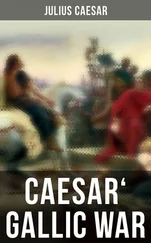Napoleon III - History of Julius Caesar Vol. 2 of 2
Здесь есть возможность читать онлайн «Napoleon III - History of Julius Caesar Vol. 2 of 2» — ознакомительный отрывок электронной книги совершенно бесплатно, а после прочтения отрывка купить полную версию. В некоторых случаях можно слушать аудио, скачать через торрент в формате fb2 и присутствует краткое содержание. Жанр: foreign_antique, foreign_prose, Биографии и Мемуары, на английском языке. Описание произведения, (предисловие) а так же отзывы посетителей доступны на портале библиотеки ЛибКат.
- Название:History of Julius Caesar Vol. 2 of 2
- Автор:
- Жанр:
- Год:неизвестен
- ISBN:нет данных
- Рейтинг книги:4 / 5. Голосов: 1
-
Избранное:Добавить в избранное
- Отзывы:
-
Ваша оценка:
- 80
- 1
- 2
- 3
- 4
- 5
History of Julius Caesar Vol. 2 of 2: краткое содержание, описание и аннотация
Предлагаем к чтению аннотацию, описание, краткое содержание или предисловие (зависит от того, что написал сам автор книги «History of Julius Caesar Vol. 2 of 2»). Если вы не нашли необходимую информацию о книге — напишите в комментариях, мы постараемся отыскать её.
History of Julius Caesar Vol. 2 of 2 — читать онлайн ознакомительный отрывок
Ниже представлен текст книги, разбитый по страницам. Система сохранения места последней прочитанной страницы, позволяет с удобством читать онлайн бесплатно книгу «History of Julius Caesar Vol. 2 of 2», без необходимости каждый раз заново искать на чём Вы остановились. Поставьте закладку, и сможете в любой момент перейти на страницу, на которой закончили чтение.
Интервал:
Закладка:
301
The Ambivariti were established on the left bank of the Meuse, to the west of Ruremonde, and to the south of the marshes of Peel.
302
De Bello Gallico , IV. 13.
303
“Acie triplici instituta.” Some authors have translated these words by “the army was formed in three columns;” but Cæsar, operating in a country which was totally uncovered and flat, and aiming at surprising a great mass of enemies, must have marched in order of battle, which did not prevent each cohort from being in column.
304
Attacked unexpectedly in the afternoon, while they were sleeping. (Dio Cassius, XXXIX. 48.)
305
The study of the deserted beds of the Rhine leads us to believe that the confluence of the Waal and the Meuse, which is at present near Gorkum, was then much more to the east, towards Fort Saint-André. In that case, Cæsar made no mistake in reckoning eighty miles from the junction of the Waal and the Meuse to the mouth of the latter river.
306
De Bello Gallico , IV. 14, 15.
307
The following reasons have led us to adopt Bonn as the point where Cæsar crossed the Rhine: —
We learn from the “Commentaries” that in 699 he debouched in the country of the Ubii, and that two years later it was a little above ( paulum supra ) the first bridge that he established another, which joined the territory of the Treviri with that of the Ubii. Now everything leads to the belief that, in the first passage as in the second, the bridge was thrown across between the frontiers of the same peoples; for we cannot admit, with some authors, that the words paulum supra apply to a distance of several leagues. As to those who suppose that the passage was effected at Andernach, because, changing with Florus the Meuse ( Mosa ) into Moselle, they placed the scene of the defeat of the Germans at the confluence of the Moselle and the Rhine, we have given the reasons for rejecting this opinion. We have endeavoured to prove, in fact, that the battle against the Usipetes and the Tencteri had for its theatre the confluence of the Meuse and the Rhine; and since, in crossing this latter river, Cæsar passed from the country of the Treviri into that of the Ubii, we must perceive that after his victory he must necessarily have proceeded up the valley of the Rhine to go from the territory of the Menapii to the Treviri, as far up as the territory of the Ubii, established on the right bank.
This being admitted, it remains to fix, within the limits assigned to these two last peoples, the most probable point of passage. Hitherto, Cologne has been adopted; but, to answer to the data of the “Commentaries,” Cologne appears to us to be much too far to the north. In fact, in the campaign of 701, Cæsar, having started from the banks of the Rhine, traversed the forest of the Ardennes from east to west, passed near the Segni and the Condrusi, since they implored him to spare their territory, and directed his march upon Tongres. If he had started from Cologne, he would not have crossed the countries in question. Moreover, in this same year, 2,000 Sicambrian cavalry crossed the Rhine thirty miles below the bridge of the Roman army. Now, if this bridge had been constructed at Cologne, the point of passage of the Sicambri, thirty miles below, would have been at a very great distance from Tongres, where, nevertheless, they seem to have arrived very quickly.
On the contrary, everything is explained if we adopt Bonn as the point of passage. To go from Bonn to Tongres, Cæsar proceeded, as the text has it, across the forest of the Ardennes; he passed through the country of the Segni and Condrusi, or very near them; and the Sicambri, crossing the Rhine thirty miles below Bonn, took the shortest line from the Rhine to Tongres. Moreover, we cannot place Cæsar’s point of passage either lower or higher than Bonn. Lower, that is, towards the north, the different incidents related in the “Commentaries” are without possible application to the theatre of the events; higher, towards the south, the Rhine flows upon a rocky bed, where the piles could not have been driven in, and presents, between the mountains which border it, no favourable point of passage. We may add that Cæsar would have been much too far removed from the country of the Sicambri, the chastisement of whom was the avowed motive of his expedition.
Another fact deserves to be taken into consideration: that, less than fifty years after Cæsar’s campaigns, Drusus, in order to proceed against the Sicambri – that is, against the same people whom Cæsar intended to combat – crossed the Rhine at Bonn. (Florus, IV. 12.)
308
The following passage has given room for different interpretations: —
“Hæc utraque insuper bipedalibus trabibus immissis, quantum eorum tignorum junctura distabat, binis utrimque fibulis ab extrema parte distinebantur; quibus disclusis atque in contrariam partem revinctis, tanta erat operis firmitudo atque ea rerum natura, ut, quo major vis aquæ se incitavisset, hoc arctius illigata tenerentur.” ( De Bello Gallico , IV. 17.)
It has not been hitherto observed that the words hæc utraque relate to the two couples of one row of piles, and not to the two piles of the same couple. Moreover, the words quibus disclusis , &c., relate to these same two couples, and not, as has been supposed, to fibulis .
309
De Bello Gallico , IV. 20.
310
De Bello Gallico , II. 4.
311
De Bello Gallico , V. 13.
312
Pliny, Hist. Nat. , IV. 30, § 16.
313
Pliny, Hist. Nat. , IV. 30, § 16. – Tacitus, Agricola , 10.
314
De Bello Gallico , V. 12.
315
Strabo, IV., p. 199.
316
Agricola , 12.
317
De Bello Gallico , V. 12.
318
De Bello Gallico , V. 13 and 14.
319
De Bello Gallico , V. 20.
320
Annales , XIV. 33.
321
Although the greater number of manuscripts read Cenimagni , some authors have made two names of it, the Iceni and the Cangi .
322
The Anderida Silva , 120 miles in length by 30 in breadth, extended over the counties of Sussex and Kent, in what is now called the Weald . (See Camden, Britannia , edit. Gibson, I., col. 151, 195, 258, edit. of 1753.)
323
Diodorus Siculus, V. 21. – Tacitus, Agricola , 12.
324
IV., p. 200.
325
Agricola , 11.
326
Diodorus Siculus, V. 21.
327
De Bello Gallico , V. 21.
328
De Bello Gallico , V. 14.
329
Strabo, IV., p. 200.
330
De Bello Gallico , V. 14.
331
Pliny, Hist. Nat. , XXII. 1.
332
De Bello Gallico , V. 14.
333
Diodorus Siculus, V. 22.
334
Diodorus Siculus, V. 22. – Strabo, IV., p. 200.
Читать дальшеИнтервал:
Закладка:
Похожие книги на «History of Julius Caesar Vol. 2 of 2»
Представляем Вашему вниманию похожие книги на «History of Julius Caesar Vol. 2 of 2» списком для выбора. Мы отобрали схожую по названию и смыслу литературу в надежде предоставить читателям больше вариантов отыскать новые, интересные, ещё непрочитанные произведения.
Обсуждение, отзывы о книге «History of Julius Caesar Vol. 2 of 2» и просто собственные мнения читателей. Оставьте ваши комментарии, напишите, что Вы думаете о произведении, его смысле или главных героях. Укажите что конкретно понравилось, а что нет, и почему Вы так считаете.












